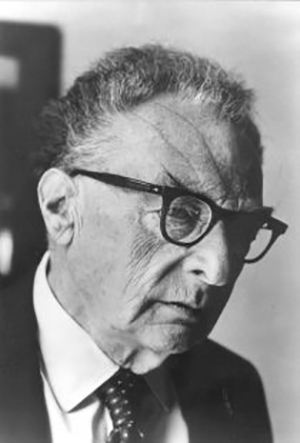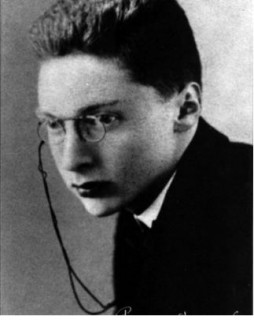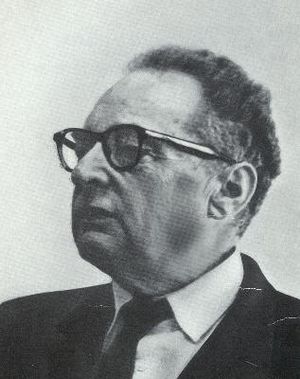Roman Jakobson facts for kids
Quick facts for kids
Roman Jakobson
|
|
|---|---|
 |
|
| Born |
Roman Osipovich Jakobson
11 October [O.S. 29 September] 1896 |
| Died | 18 July 1982 (aged 85) Cambridge, Massachusetts, U.S.
|
| Alma mater | Lazarev Institute of Oriental Languages Moscow University |
| Spouse(s) | Svatava Pirkova, Krystyna Pomorska |
| School | Moscow linguistic circle Prague linguistic circle |
|
Main interests
|
Linguistics |
|
Notable ideas
|
Jakobson's functions of language Markedness |
|
Influences
|
|
|
Influenced
|
|
Roman Osipovich Jakobson (born October 11, 1896 – died July 18, 1982) was a very important Russian linguist and literary theorist. He studied language and how stories are told.
Jakobson was a leader in a field called structural linguistics. He was one of the most famous and influential linguists of the 1900s. With another linguist, Nikolai Trubetzkoy, he created new ways to study language sounds. This helped start the modern study of phonology, which is about sound systems in language.
He also used these ideas to study other parts of language. These included syntax (how words form sentences), morphology (how words are formed), and semantics (the meaning of words). He helped us understand Slavic languages, especially Russian. He looked at how Russian words change their endings and how Russian verbs work.
Jakobson also studied how we use language in poetry, music, art, and movies. He used ideas from semiotics, which is the study of signs and symbols. His work greatly influenced thinkers like Claude Lévi-Strauss and Roland Barthes. He helped spread the idea of "structuralism" beyond just language. Structuralism became a big way of thinking in Europe and the U.S. after World War II.
Even though structuralism became less popular later, Jakobson's ideas are still important. They are used in linguistic anthropology, which studies language in different cultures. His ideas also influenced Noam Chomsky, another very important linguist.
Contents
Roman Jakobson: A Life of Language Discovery
Roman Jakobson was born in Moscow, Russia, on October 11, 1896. His parents were well-off; his father was an industrialist and his mother was a chemist. Roman loved language from a very young age.
He studied at the Lazarev Institute of Oriental Languages and then at Moscow University. As a student, he was a key member of the Moscow linguistic circle. He was also involved in Moscow's exciting world of modern art and poetry. He was especially interested in Russian Futurism, a type of art movement. He even published poetry under the name 'Aliagrov'. He became friends with famous artists and poets like Vladimir Mayakovsky. The poetry of his time helped inspire him to become a linguist.
At that time, many linguists mainly studied how words changed over time. This was called the diachronic approach. But Jakobson learned about the work of Ferdinand de Saussure. Saussure focused on how language works at a specific point in time, which is called the synchronic approach. Jakobson became interested in how language structure helps it communicate information. He earned his master's degree from Moscow University in 1918.
Moving to Czechoslovakia
Jakobson was excited about the Bolshevik revolution at first. But he soon became disappointed. The government started to control art and creativity more and more. So, in 1920, he left Moscow and moved to Prague, in Czechoslovakia. He worked for the Soviet diplomatic mission there and continued his studies.
In Czechoslovakia, he was close to Nikolai Trubetzkoy, who became his most important partner. Trubetzkoy had also left Russia and was teaching in Vienna. In 1926, the Prague School of language theory was started. Jakobson was a founding member and a main thinker. Other members included Trubetzkoy and René Wellek. Jakobson became deeply involved in the academic and cultural life of Czechoslovakia before World War II. He became good friends with many Czech poets and writers. He received his Ph.D. from Charles University in 1930. In 1933, he became a professor at Masaryk University in Brno.
Escaping World War II
When World War II began, Jakobson had to leave Prague. In March 1939, he escaped through Berlin to Denmark. There, he worked with the Copenhagen linguistic circle. On September 1, 1939, he fled to Norway. In 1940, he walked across the border to Sweden. He continued his work there, studying language problems caused by brain injuries.
When his Swedish friends worried about a German invasion, he managed to leave on a cargo ship. He traveled with Ernst Cassirer, a famous philosopher, to New York City in 1941. In New York, he joined many other smart people who had fled Europe.
Life and Work in the United States
In New York, Jakobson started teaching at The New School. He worked closely with other Czech people who had moved there. At a French-speaking university for exiles, he met and worked with Claude Lévi-Strauss. Lévi-Strauss also became a key person in the structuralism movement. Jakobson also met many American linguists and anthropologists, like Franz Boas and Benjamin Whorf. When the U.S. authorities thought about sending him back to Europe, Franz Boas helped him stay.
In 1949, Jakobson moved to Harvard University. He stayed there until he retired in 1967. His ideas about how language sounds are organized became very famous. He wrote a book about it in 1951 with C. Gunnar Fant and Morris Halle. In the same year, his ideas about "distinctive features" greatly influenced young Noam Chomsky. Chomsky later became the most important person in language theory in the second half of the 1900s.
In his later years, Jakobson had an office at the Massachusetts Institute of Technology. He was an honorary professor there. In the early 1960s, he started to look at language more broadly. He began writing about communication science as a whole. He passed away in Cambridge, Massachusetts, on July 18, 1982.
Roman Jakobson's Big Ideas
Jakobson felt that the time he spent as a young student in Russia, from 1912 to 1920, was very important for his ideas. During this time, he was inspired by Velimir Khlebnikov, a famous Russian writer and language thinker.
One of his most important ideas was about the "sound shape of language." He worked with Trubetzkoy in the 1920s and 1930s. They developed the idea of the phoneme, which is the smallest unit of sound that can change the meaning of a word. For example, the difference between 'pat' and 'bat' is one phoneme.
Later, he developed the idea of "binary distinctive features." This means that sounds can be described by simple "yes" or "no" choices. For example, a sound might be "voiced" (vibrating vocal cords) or "unvoiced" (no vibration). These features are the basic building blocks of language sounds.
How We Communicate: Jakobson's Six Functions
Jakobson identified six main ways we use language to communicate. Each way is linked to a different part of the communication process:
- Referential: This is about giving facts or information about the world. Like saying, "The sky is blue."
- Poetic: This focuses on the message itself, how it sounds, and its beauty. This is often found in poetry.
- Emotive: This shows the speaker's feelings or emotions. Like saying, "Wow!"
- Conative: This tries to get the listener to do something. Like saying, "Come here!"
- Phatic: This checks if the communication channel is working. Like saying, "Hello?" or "Can you hear me?"
- Metalingual: This talks about the language itself. Like saying, "What does 'linguistics' mean?"
One of these functions is usually the main one in any piece of communication. For example, in a poem, the poetic function is usually the most important. Jakobson's theory helps us understand the different reasons why we use language.
Jakobson's Lasting Influence
Jakobson's ideas continue to be very important in language studies today. Three of his main ideas are:
- Linguistic typology: This is about classifying languages based on their shared grammar features, not just where they came from.
- Markedness: This looks at how some language forms are more "basic" or "optimized" than others.
- Linguistic universals: This is the study of features that are common to all languages in the world.
He also influenced many other thinkers in different fields. These include Dell Hymes (who studied how culture affects communication) and Jacques Lacan (a psychoanalyst). His work has had a huge impact on people who study Slavic languages, especially in North America.
Images for kids
Error: no page names specified (help). In Spanish: Roman Jakobson para niños
In Spanish: Roman Jakobson para niños




